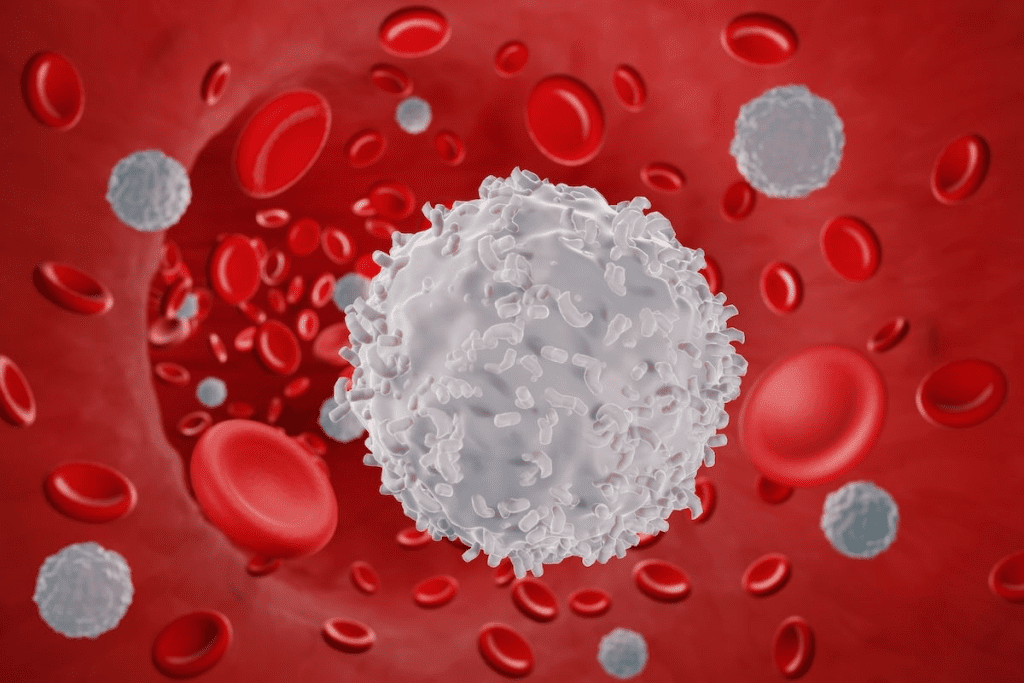Last Updated on November 25, 2025 by
An increase of leukocyte in urine during pregnancy is common and may signal a UTI, which is a key reason for routine screening.
Pregnancy changes a woman’s body in many ways, including how white blood cells in urine work. Leukocytes are part of the immune system, fighting infections. In pregnancy, the body makes changes that can affect these cells.
It’s important to understand these changes. They help keep both the mother and the baby healthy.

As the body adjusts to pregnancy, the risk of urinary tract infections (UTIs) goes up. This can lead to more leukocytes in the urine. It’s key to watch these levels closely.
High leukocyte levels can mean serious health issues. This is why trusted health resources say it’s important to get medical help right away.
Leukocytes, or white blood cells, are key to our immune system. Their levels can change during pregnancy. It’s important to understand these changes to keep pregnant women healthy.
Leukocytes help fight infections and protect us. A healthy person has 4,000 to 10,000 leukocytes per cubic millimeter of blood. They are vital for our health and in fighting diseases.
Pregnancy brings many changes to support the growing fetus. One change is an increase in white blood cells. This helps protect both the mother and the fetus from infections.
In pregnant women, urine leukocyte counts can go up to 0“30/μL. This is different from non-pregnant women. Here are some key differences:
These changes are part of the body’s natural response to pregnancy. But very high leukocyte levels could mean an infection. This needs medical attention.

Pregnancy brings many changes to the body, affecting the immune system and urine leukocyte levels. We’ll look into why these changes happen, focusing on immune system adjustments, hormonal effects, and body changes.
Pregnancy makes the immune system change to support the growing fetus. This balance helps the body accept the fetus while keeping the mother safe. As a result, elevated leukocytes can show up because of these immune system adjustments.
The immune system becomes more tolerant to prevent rejecting the fetus. But this tolerance can sometimes cause an increase in leukocytes. This is because the body is ready to fight off threats. Key changes include:
Hormonal shifts in pregnancy affect the urinary system. For example, higher progesterone levels can cause ureteral dilation and change urine flow. This can lead to more leukocytes.
Hormonal changes also affect the immune response in the urinary tract. It’s important to understand these hormonal effects to make sense of leukocyte changes during pregnancy.

As pregnancy goes on, the uterus expands, putting pressure on the urinary tract. This pressure can cause urine to stay in the tract longer, raising the risk of infections and elevated leukocytes.
These changes highlight the need to watch urinary health during pregnancy. Knowing about these changes helps healthcare providers understand urinalysis results better and manage any issues.
Important factors to keep in mind include:
Recent studies have shed light on urinary leukocytes in pregnant women. They offer insights into pregnancy changes.
We will look at a key study on leukocytes in pregnant women’s urine. This study had 612 healthy pregnant women. It compared their leukocyte counts to those of non-pregnant women.
A study in a top medical journal looked at 612 healthy pregnant women’s urine. It aimed to find the normal leukocyte range in pregnant women. It also compared this to non-pregnant women.
The study found pregnant women had much higher WBC counts in their urine. This shows a possible response to pregnancy changes.
The study found pregnant women’s urine had a median WBC count much higher than that of non-pregnant women. Hormonal changes and pregnancy adaptations likely cause this.
It also found more bacteria and epithelial cells in pregnant women’s urine. This suggests pregnancy may change the urinary tract. This can lead to more of these elements in the urine.
The study found pregnant women had more bacteria and epithelial cells in their urine. This is important. It may mean a higher risk of urinary tract infections during pregnancy.
These findings are key when checking the urinary health of pregnant women. The presence of more leukocytes, bacteria, and epithelial cells may need closer monitoring. It might also require different management strategies than for non-pregnant women.
It’s important to know how to diagnose UTIs in pregnant women. This is because the urinary tract and immune system change during pregnancy. This makes it harder to spot UTIs.
Doctors look for five or more leukocytes per high-power field to diagnose UTIs in pregnant women. This rule helps doctors know who needs more tests or treatment.
Standard UTI tests might not work as well during pregnancy. Physiological changes like a bigger urinary tract and hormonal shifts can mess with the test results.
The leukocyte esterase test is used to find UTIs. But it’s tricky to read the results in pregnant women because of the body’s changes.
We need to think about these issues when we diagnose and treat UTIs in pregnant women. This helps us get the best results for them.
Urinalysis during pregnancy needs careful attention because of false positives. These false positives can cause unnecessary stress and extra tests. Knowing how to avoid them is key.
One big reason for false positives in pregnancy urinalysis is contamination. Contamination happens when urine touches outside substances, like bacteria from the genital area or hands. Keeping things clean and using the right collection methods is very important.
Vaginal discharge can also affect urinalysis results during pregnancy. Discharge can mix with the urine sample, causing false positives for infections. We’ll look at how to tell if it’s a real infection or just discharge.
To cut down on false positives, healthcare providers suggest better collection methods. Using a clean-catch midstream urine collection method helps a lot. We also tell patients to keep their genital area clean before collecting the sample.
By knowing why false positives happen and using better collection methods, we can make urinalysis more accurate during pregnancy.
It’s important for pregnant women and their doctors to know when leukocytes in urine are a worry. Some increase in leukocytes is normal during pregnancy. But it’s key to tell normal changes from signs of infection.
Pregnancy brings many changes that can affect leukocyte counts. But a big jump in leukocytes might mean an infection that needs doctor care. We need to watch for signs that show normal changes versus serious problems.
Elevated leukocytes in urine can come from many things, like:
Pregnant women should see a doctor if they have:
If leukocytes show an infection and it’s not treated, it can cause big problems like:
It’s vital for pregnant women to go to all their prenatal visits. They should tell their doctor about any symptoms that worry them. Catching and treating infections early can help avoid serious issues.
Knowing the signs of elevated leukocytes helps pregnant women stay healthy and protect their baby.
Monitoring urinary leukocytes is key in prenatal care. It helps keep both mom and baby healthy. Regular checks are important to catch any issues early.
Doctors check for urinary leukocytes at the first visit and sometimes later. Early detection of elevated leukocytes can help prevent complications from urinary tract infections. Pregnant women should have urinalysis as part of their care to look for leukocytes.
If leukocytes are high, more tests are done to confirm an infection. A urine culture might be needed to find the cause. Prompt follow-up testing is key to choosing the right treatment. We also think about how the test was done.
When an infection is confirmed, we start treatment right away. Antibiotic therapy is usually the first choice, picked based on safety during pregnancy. We teach patients how to avoid future infections, too.
These steps help improve health outcomes for pregnant women and their babies. Good prenatal care means treating infections and teaching about urinary health.
We’ve looked into how pregnancy changes leukocyte levels in urine. It’s key to watch these changes. High leukocytes might mean a urinary tract infection, which needs quick action during pregnancy.
Good prenatal care is vital for handling urinary tract infections. It keeps both mom and baby healthy. Regular checks and tests help catch problems early.
At Liv Hospital, we’re all about giving top-notch support and advice during pregnancy. We use the latest methods and always look for ways to improve. This way, we offer personalized care that’s second to none.
Knowing about leukocyte level changes in pregnancy helps us manage health better. Our team is ready to give the care and support needed for a healthy pregnancy.
Leukocytes, or white blood cells, are key to our immune system. They fight infections. When you see them in your urine, it might mean you have an infection or inflammation in your urinary tract.
Pregnancy makes white blood cell counts go up. This is due to changes in the immune system, hormones, and body structure. It can cause more leukocytes in urine, which might show a urinary tract infection or other issues.
Usually, 0-5 leukocytes per high-power field is normal. But some studies say up to 30/μL can be okay for pregnant women.
Doctors test for leukocyte esterase, nitrite, and white blood cells in urine. They look for five or more leukocytes per high-power field. But these standards might not always work during pregnancy.
False positives can come from contamination, vaginal discharge, and other factors. Better collection methods can lower these false positives.
If you have pain while urinating, need to pee a lot, or feel abdominal pain, see a doctor. High leukocytes might mean an infection. If not treated, it could cause serious problems like preeclampsia.
Doctors do regular urinalysis to check for leukocytes and infection signs. If leukocytes are high, they do more tests and start treatment for infections.
Untreated infections can harm the kidneys, cause preterm labor, and lead to preeclampsia. It’s important to get medical help quickly to avoid these problems.
Keeping clean, drinking plenty of water, and going to prenatal check-ups can help prevent UTIs. This ensures early detection and treatment.
Subscribe to our e-newsletter to stay informed about the latest innovations in the world of health and exclusive offers!